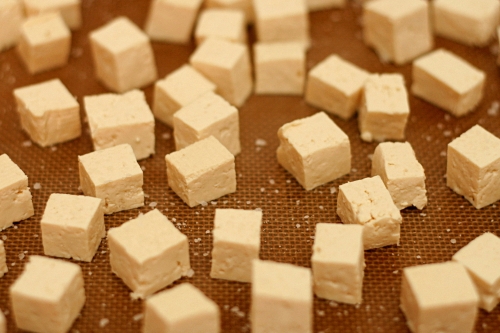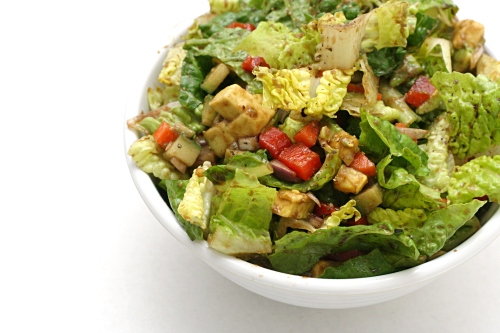
Let me give you some insight into what kind of person my husband is. For his birthday a few weeks ago, I offered to make whatever he wanted for dinner, for an entire weekend. The first two meals he chose, salmon pesto pasta and sushi, were predictable. The last one is what made me roll my eyes – he requested salad. When questioned about specifics, all he could come up with “lots of different kinds of lettuce is always nice.”

Really? Who requests leafy green salad for a birthday dinner? I like salad, but I don’t consider it a treat.
Fortunately, other than that general guideline, I could do whatever I wanted with it. I thought these tofu croutons would be a good protein source, and then I could serve the salad with tasty homemade garlic bread.

My first run-through with these croutons wasn’t absolutely successful. I followed the recipe exactly, but from the beginning, there were two things that I was uncertain about. One was the lack of salt. It’s not like tofu has so much flavor on its own that it can pass without anything extra to give it a boost. The other was the size that the tofu cubes were supposed to be cut into. They seemed big, but I wasn’t sure how much they would shrink after baking, so I kept them at the 1-inch cubes the recipe recommended.

The results were, sure enough, too big and too bland. The second time I made them, I cut the tofu into half-inch cubes and sprinkled some kosher salt over them before baking, and I liked them a lot more. The outsides are crispy, the insides are meaty, and the overall flavor is nutty. Their taste, texture, and nutrition make them a really great addition to salad.

One year ago: Potstickers
Tofu Croutons (adapted from Mark Bittman’s How to Cook Everything Vegetarian)
Enough croutons for 2-3 salad servings
I didn’t actually measure the salt when I sprinkled it on. I know I used too much, and I really don’t think you need much.
I only recently figured out that there’s two kinds of tofu – regular (or brick or Chinese) and silken (or Japanese). Regular is packed in water, not sold in the aseptic boxes. That’s what I used here. It has a chewier, “meatier” texture.
14 ounces firm tofu
¼ teaspoon kosher salt
1 tablespoon olive oil
1. Adjust an oven rack to the middle position and heat the oven to 400F.
2. Cut the block of tofu in half lengthwise (so from a rectangle into two flatter rectangles). Use a kitchen towel to press the tofu dry (or dry-ish – you don’t need to put tons of effort into this).
3. Cut the slices into ½-inch cubes. Put the cubes on a parchment-lined baking mat and sprinkle with the salt and drizzle with the oil. Toss gently to coat.
4. Bake at 400F for about an hour, until evenly browned. There’s no need to rotate them; they’ll brown evenly. Leftovers can be stored in the refrigerator for up to 3 days. Bring to room temperature before using.










































